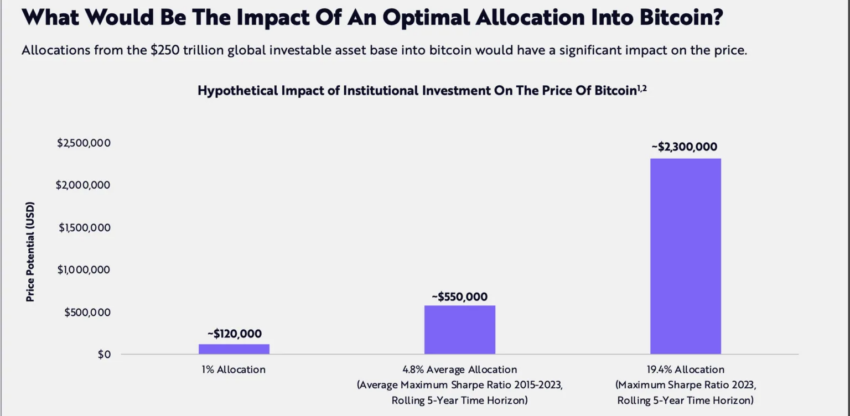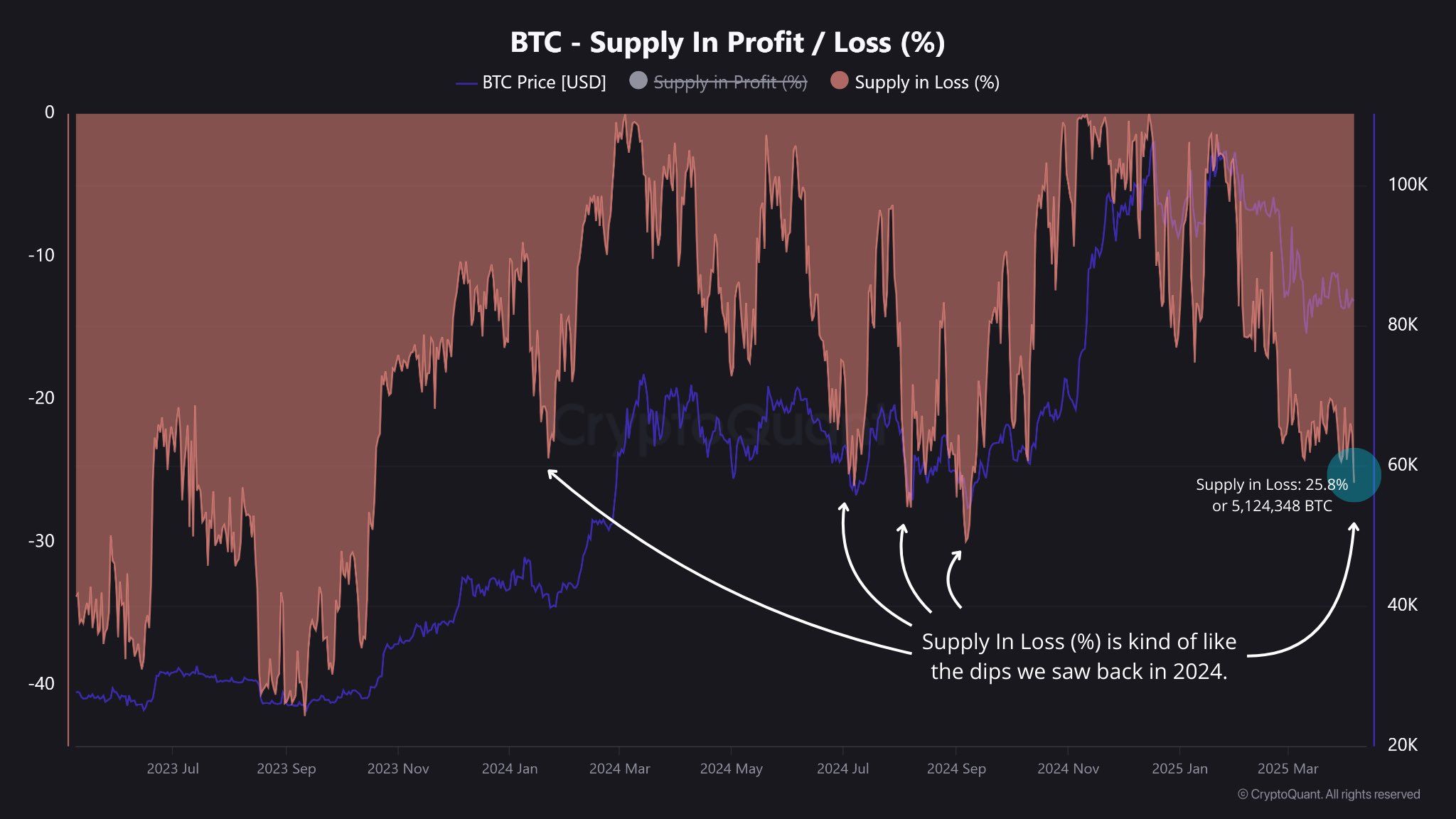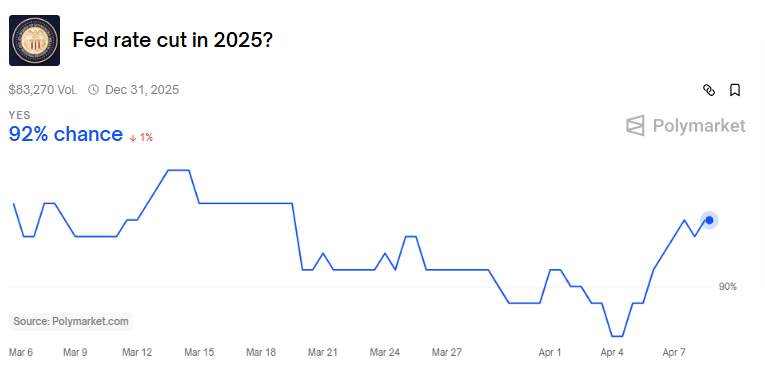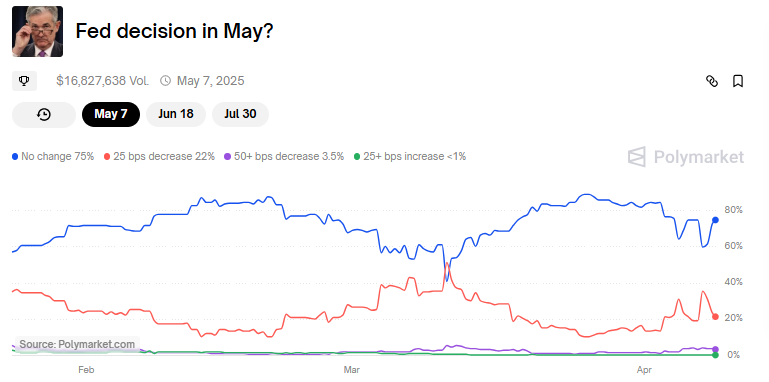Bitcoin
How Institutional Adoption Could Push Bitcoin Over $400,000

Bitcoin’s allure is growing as investors increasingly recognize its unique traits. The spot Bitcoin exchange-traded funds (ETFs) simplify the process for investors, potentially leading to a significant increase in Bitcoin’s price.
The Motley Fool analysts highlight that the approval of Bitcoin ETFs is a major step in cryptocurrency acceptance. They believe this could drive Bitcoin’s price to $400,000 or even $1 million.
Bitcoin’s Path to $400,000 and Beyond
The ETFs allow retail investors to bypass complex crypto exchanges and digital wallets, making Bitcoin more accessible.
However, the potential for substantial growth lies with institutional investors entering the Bitcoin market. These include pension funds, retirement plans, and hedge funds, which manage vast sums of money. Previously deterred by the complexities of digital assets, these institutions can now incorporate Bitcoin into their portfolios with ease, thanks to ETFs.
Read more: Bitcoin Price Prediction 2024/2025/2030
As of now, about 700 professional investment firms have invested around $5 billion in these ETFs. Leading investors include Millennium Management, which has allocated about 3% of its $64 billion portfolio to Bitcoin ETFs. Others, such as Morgan Stanley and Bracebridge Capital, along with the State of Wisconsin Investment Board, are also significant participants.
Despite this growth, institutional investors still represent only about 10% of the total ETF ownership. This figure is increasing, indicating a rising institutional interest that could significantly boost demand for Bitcoin. Institutional investors often conduct extensive due diligence before diversifying into new assets like Bitcoin.
“Yet, after conducting their research, I think they will all likely arrive at the same conclusion: Bitcoin’s inherent characteristics make it a necessity in portfolios. Eventually, widespread adoption among institutional investors will occur, leading to a tsunami of capital flowing in,” a Motley Fool analyst said.
This shift in investment isn’t just about increasing Bitcoin ownership; it involves strategic financial planning. With the vast sums managed by these institutions, even a small allocation to Bitcoin could have a major impact. If institutions allocate 5% of the $129 trillion assets they manage to Bitcoin, its market cap could exceed $7 trillion, pushing its price beyond $400,000.
Some analysts believe a 5% allocation might be too conservative. ARK Invest suggests an optimal portfolio could include up to 19% Bitcoin for the best risk-adjusted returns.
Read more: 7 Best Crypto Exchanges in the USA for Bitcoin (BTC) Trading

Their recommendation is based on a rolling 5-year analysis, which supports a higher allocation to maximize portfolio performance.
As investment strategies evolve, Bitcoin’s role in future financial portfolios appears increasingly significant. Observing the benefits reaped by their peers, more institutions might feel compelled to increase their Bitcoin investments.
Disclaimer
In adherence to the Trust Project guidelines, BeInCrypto is committed to unbiased, transparent reporting. This news article aims to provide accurate, timely information. However, readers are advised to verify facts independently and consult with a professional before making any decisions based on this content. Please note that our Terms and Conditions, Privacy Policy, and Disclaimers have been updated.
Bitcoin
Bitcoin Crashes Below $75,000 As Asian Stock Markets Bleed

Bitcoin sharply fell below $75,000 as Asian and Pacific stock markets opened on Wednesday morning, shedding 6% in a single day. Global financial markets are sinking under pressure from the US imposing a 104% tariff on Chinese imports.
The sell-off coincided with mounting fears that escalating trade tensions between the world’s two largest economies could derail global economic recovery.
Stock Markets Bleed Worldwide and Bitcoin Follows
In Asia, Japan’s Nikkei 225 plummeted nearly 4% at the open, while markets in South Korea, Australia, and New Zealand also posted significant declines.
Australian stocks opened 2% lower, wiping out gains from the previous session amid waning hopes for a US-China trade resolution.
The S&P 500 plunged 1.6%, reversing an earlier 4.1% gain and pushing the index nearly 19% below its February peak. The Dow Jones Industrial Average slipped 0.8%, while the tech-heavy Nasdaq dropped 2.1%.
The sharp crypto correction triggered nearly $400 million in daily liquidations, led by leveraged long positions.

Notably, Bitcoin’s long-short ratio flipped for the first time in weeks, with short positions now accounting for 55% of open interest—a clear sign of bearish sentiment overtaking the market.
Investors are quickly de-risking across asset classes, bracing for further volatility as the trade dispute escalates.

Trump’s additional 104% tariffs on China and the lack of diplomatic progress have intensified uncertainty, prompting traders to seek liquidity and shift to defensive strategies.
With Bitcoin often seen as a barometer of macro risk appetite, its decline underscores the market’s growing unease.
Disclaimer
In adherence to the Trust Project guidelines, BeInCrypto is committed to unbiased, transparent reporting. This news article aims to provide accurate, timely information. However, readers are advised to verify facts independently and consult with a professional before making any decisions based on this content. Please note that our Terms and Conditions, Privacy Policy, and Disclaimers have been updated.
Bitcoin
Bitcoin Whale Activity Peaks Amid Market Uncertainty

According to Glassnode, Bitcoin whales—entities holding over 10,000 BTC—achieved an accumulation score of approximately 1.0 earlier this month, reflecting intense buying activity.
This score marks a significant deviation from the behavior of smaller holders, who are leaning toward distribution.
Why Bitcoin Whales Are Buying While Smaller Holders Sell
Glassnode highlighted the shift in the latest X (formerly Twitter) post.
“Whales holding >10,000 BTC briefly hit a perfect accumulation score (~1.0) at the turn of the month,” Glassnote posted.

This score reflected a 15-day period of intense purchasing activity. However, after this spike, the score slightly eased to around 0.65. While this suggested a more moderate pace of buying, it still pointed to steady accumulation by large holders.
Meanwhile, smaller Bitcoin holders, categorized as those with holdings between <1 BTC and 100 BTC, shifted their focus to distribution. On-chain data revealed that these cohorts have significantly increased their selling activity, with accumulation scores trending down to between 0.1 and 0.2.
“This divergence shows the bigger players are still accumulating, while smaller holders are selling. Market sentiment remains split,” a user noted on X.
The growing gap between the actions of large and small holders is indicative of differing market sentiments. Whales appear to be betting on Bitcoin’s long-term growth. At the same time, smaller holders may be more cautious or reactive, choosing to liquidate their positions as a hedge against potential market downturns.
The contrasting strategies come amid heightened geopolitical tensions and trade war concerns, which some analysts believe will drive Bitcoin’s appeal as a hedge. Industry expert Will Clemente recently weighed in on the broader implications.
“Zooming out, seeds are being sown for global accumulation of BTC for not only hedging against money supply but de-globalization and geopolitical tensions. These allocations won’t come overnight, but this is what Bitcoin was made for,” Clemente remarked.
Despite the long-term optimism, the macroeconomic conditions have weighed heavily on BTC, causing it to drop below $80,000. Nonetheless, BeInCrypto data showed that Bitcoin saw modest gains of 5.0% over the past day. At the time of writing, it traded at $79,454.

Notably, the price dip has led to significant unrealized losses for public companies holding Bitcoin reserves, with many now seeing their holdings valued below their acquisition costs. In fact, Strategy even paused its Bitcoin purchases, reflecting caution in the face of market uncertainty.
Moreover, data from CryptoQuant disclosed that 25.8% of the total Bitcoin supply is in loss.

“While it might seem alarming, it’s not unprecedented,” the post noted.
CryptoQuant added that similar scenarios have occurred throughout 2024, where a substantial portion of Bitcoin was also held at a loss. For instance, in January 2024, 24.1% of the circulating Bitcoin was underwater. In September, that figure rose to 29.9%.
Thus, these fluctuations show that periods of Bitcoin being held at a loss are not unusual and are part of the market’s cyclical nature, where price corrections affect a significant share of the supply.
Disclaimer
In adherence to the Trust Project guidelines, BeInCrypto is committed to unbiased, transparent reporting. This news article aims to provide accurate, timely information. However, readers are advised to verify facts independently and consult with a professional before making any decisions based on this content. Please note that our Terms and Conditions, Privacy Policy, and Disclaimers have been updated.
Bitcoin
Will the Fed Return to Quantitative Easing?

Crypto and financial markets, in general, are reeling from renewed volatility and mounting geopolitical pressure. As a result, speculation is intensifying around whether the Federal Reserve (Fed) will pivot back toward Quantitative Easing (QE).
A potential QE would be reminiscent of the aggressive monetary interventions of 2008 and 2020. For crypto, the implications could be enormous, with many traders bracing for a potential V-shaped recovery and a historic rally if QE is revived.
Analysts Share Signals Why the FED Could Act
Analysts have shared reasons that could prompt the Fed to intervene, with one citing the MOVE Index. This is Wall Street’s “fear gauge” for the bond market. At 137.30, the index is currently within the 130–160 range where the Fed has historically acted during crises.
“Now it’s at 137.30, in the 130–160 range where the Fed might step in, depending on the economy. If they don’t, they’ll still cut rates soon because they have to refinance the debt to keep the Ponzi going,” wrote Vandell, co-founder of Black Swan Capitalist.

This signal aligns with other warning signs of financial instability, including global market sell-offs that set the tone for the crypto black Monday narrative. This prompted the Fed to schedule a closed-door board meeting on April 3.
According to analysts, this timing was not random, with mounting pressure likely to see the Fed cave and President Trump having his way.
“With the Fed hinting at QE, everything changes Risk: Reward is now in favor of the bulls. Watch for choppy price action, but do not miss the recovery rally. And remember… it’s easier to trade this market than to hold through it,” said Aaron Dishner, a crypto trader and analyst.
This suggests that investors are reading between the lines, particularly with the Fed’s next scheduled policy decision not until May 6–7. JPMorgan recently became the first Wall Street bank to forecast a US recession amid Donald Trump’s proposed tariffs, adding urgency to the conversation.
The bank suggests the Fed may be forced to act sooner, possibly with rate cuts or even QE, before the scheduled FOMC meeting. Against this backdrop, crypto investor Eliz shared a provocative take.
“I honestly think Trump is doing all this to speed up the Fed’s process to lower rates and QE,” they noted.
That may not be far-fetched given that the Fed must also manage over $34 trillion in federal debt. Noteworthy, this becomes harder to service at higher interest rates. According to Polymarket, there is now a 92% chance the Fed will cut rates at some point in 2025.

Why Crypto Could Benefit From QE
Should QE materialize, history suggests crypto could be one of the biggest beneficiaries. BitMEX founder and former CEO Arthur Hayes predicted that QE could inject up to $3.24 trillion into the system, nearly 80% of the amount added during the pandemic.
“Bitcoin rose 24x from its COVID-19 low thanks to $4 trillion in stimulus. If we see $3.24 trillion now, BTC could hit $1 million,” he said.
This aligns with his recent prediction that Bitcoin could reach $250,000 by year-end if the Fed shifts to QE to support markets.
Analyst Brett offered a more measured view, noting that QE typically follows rate cuts rather than precedes them.
“We’re likely going to see rate cuts through mid-2026…like in 2008 and 2020, Powell has said QE doesn’t come until rate cuts are complete,” Brett explained.

Based on this, the analyst committed to buying selectively but did not expect a V-shaped bounce unless something drastic changed.
That “something” could be Trump reversing his tariffs or the Fed front running a recession with emergency easing measures. If either happens, the crypto market could rally hard and fast.
Altseason on the Horizon?
Meanwhile, Our Crypto Talk says a Quantitative Easing in May could lay the groundwork for a possible altcoin season.
Their forecast echoes previous cycles where QE triggered explosive moves in risk assets. When QE kicked off in March 2020, altcoins surged over 100X by the time it ended in 2022.
Traders are now eyeing May as a potential kickoff for the next liquidity wave, with bettors wagering a 75% chance the Fed will hold rates steady. If those odds shift, traders expect the money printer to follow.

While some anticipate more price “chop” in the short term, most agree that the long-term setup is increasingly favorable.
“If QE really kicks off in May, this chop is just the calm before the giga pump,” wrote MrBrondorDeFi on X.
Even if quantitative easing does not occur immediately, confidence remains strong that it will happen this year.
“Maybe not May, then later. It will happen this year, which is good for another rally and new highs,” Our Crypto Talk added.
Therefore, the buck stops with the Fed. Whether it is rate cuts, QE, or both, the implications for crypto are enormous.
If history repeats and the Fed opens the liquidity floodgates again, Bitcoin and altcoins could be poised for a historic breakout. This could eclipse the gains seen during the 2020-2021 bull run.
Disclaimer
In adherence to the Trust Project guidelines, BeInCrypto is committed to unbiased, transparent reporting. This news article aims to provide accurate, timely information. However, readers are advised to verify facts independently and consult with a professional before making any decisions based on this content. Please note that our Terms and Conditions, Privacy Policy, and Disclaimers have been updated.
-

 Altcoin20 hours ago
Altcoin20 hours agoBitcoin +6%, Ethereum +10% Amid Tariff Uncertainty; FARTCOIN Skyrockets +38%, Recovery or Bubble?
-

 Ethereum19 hours ago
Ethereum19 hours agoHere’s Where Ethereum’s Last Line Of Defense Lies, According To On-Chain Data
-

 Market24 hours ago
Market24 hours agoXRP Price Recovery Fades—$2 Remains A Tough Nut to Crack
-

 Market22 hours ago
Market22 hours agoCardano (ADA) Eyes Resistance Break—Failure Could Spark Fresh Losses
-

 Market21 hours ago
Market21 hours agoSui’s Community Passport & More This Week
-

 Altcoin21 hours ago
Altcoin21 hours agoJohn Deaton Highlights Ripple’s Journey from Legal Struggle To ETF Launches
-

 Market20 hours ago
Market20 hours agoBitcoin Price Recovery In Play—But Major Hurdles Loom Large
-

 Altcoin23 hours ago
Altcoin23 hours agoBinance Announces KERNEL As 4th Megadrop Project; Here’s The Listing Date





















